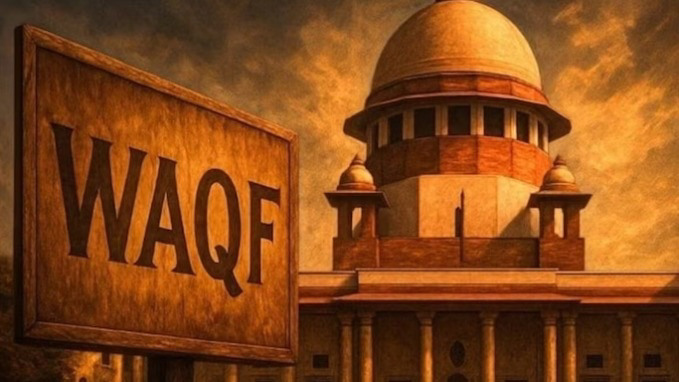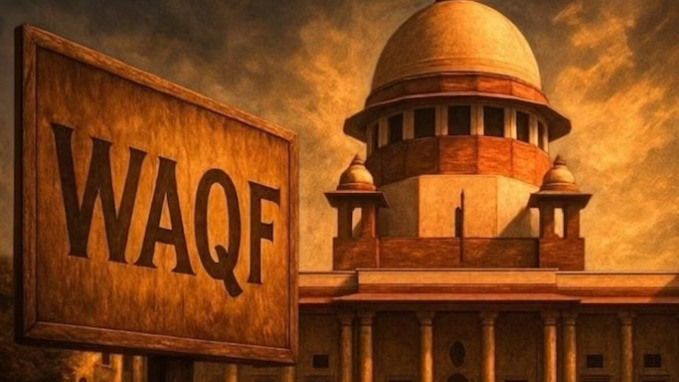Supreme Court’s Waqf Interim Order – A Partial Shield or a Slippery Slope?

In a nation where faith and law often collide, the Supreme Court’s interim order on September 15, 2025, in the challenge to the Waqf (Amendment) Act, 2025, emerges as a pivotal moment.
Delivered by a bench comprising Chief Justice B.R. Gavai and Justice Augustine George Masih, the ruling navigates the treacherous terrain between legislative reform and minority safeguards. While halting some overreaches, it leaves others intact, prompting questions about the judiciary’s role in preserving India’s pluralistic fabric. This order, reserved since May 22 after intense hearings, underscores the Act’s ambition to digitize and democratize waqf management—yet at what cost to religious self-determination?
The Act’s Ambitious Overhaul: Reform or Reclamation?
The Waqf Amendment Act, 2025—rechristened the Unified Waqf Management, Empowerment, Efficiency and Development (UMEED) Act—seeks to modernize the administration of an estimated 9 lakh properties spanning 9.4 lakh acres, valued at over ₹1.2 lakh crore. Proponents hail it as a bulwark against encroachments and mismanagement, mandating digital registration, centralized surveys, and inclusive governance structures. Yet, detractors view it as a veiled assault on Muslim institutional autonomy, echoing broader patterns in recent legislative moves like the Citizenship Amendment Act or farm laws repealed amid protests.
Passed amid acrimonious parliamentary debates in early April 2025, the Act expands state oversight: from empowering district collectors to verify property titles to capping community input in decision-making bodies. It abolishes the longstanding doctrine of “waqf by user,” which inferred dedication from prolonged communal worship, and bars waqfs on government or tribal lands. Such clauses, critics argue, could retroactively jeopardize undocumented sites like dargahs or idgahs, many predating modern land records. The government’s 1,300-page affidavit invoked the presumption of constitutionality, but the bench’s scrutiny revealed fissures, staying select provisions while upholding the registration mandate—a continuity from the 1995 Act, albeit with extended timelines for compliance.
Dissecting the Order: Surgical Stays Amid Broader Deference
The bench’s 45-minute dictation was a masterclass in calibrated intervention. Prima facie, it rejected a blanket stay, affirming Parliament’s primacy under Entries 10 and 28 of the Concurrent List. “The presumption leans toward validity; stays on entire statutes are rare,” the Chief Justice noted, tracing the legislative arc from the 1923 Mussalman Wakf Act to today. Yet, targeted halts addressed glaring anomalies.
Foremost, Section 3(r)’s stipulation—that waqif must demonstrate five years of Islamic practice—was suspended pending rule-making by states. Absent objective criteria, the court warned, it invites “arbitrary power,” potentially turning bureaucrats into theological gatekeepers. This echoes privacy concerns under Article 21, where faith’s intangibility defies empirical proof. Similarly, a proviso to Section 3C—empowering collectors to preliminarily derecognize waqfs amid encroachment probes—was frozen. Adjudicating title disputes sans judicial oversight flouts separation of powers, the bench ruled, directing that revenue entries remain unaltered until Waqf Tribunals or High Courts resolve claims. No dispossession, no third-party transfers: a vital interim bulwark against hasty seizures.
On governance, the order tempered inclusivity’s edge. The Central Waqf Council (22 members) and State Boards (11 members) now face caps—four and three non-Muslims, respectively—curbing the Act’s open-door policy. For the ex-officio CEO under Section 23, a preference for Muslims was urged “as far as possible,” though non-Muslims aren’t barred outright. Unaddressed were Sections 3D and 3E, shielding Archaeological Survey of India monuments and tribal lands from waqf claims, and the repeal of Section 104 allowing non-Muslims to create waqfs. The latter, the court observed, aligns with the stayed 3(r), offering alternatives like trusts for charitable ends.
Notably absent: interference with waqf-by-user’s deletion or mandatory registration. The bench extended deadlines for the latter, acknowledging historical lapses from 1995-2013, but insisted on its non-novelty. This leaves thousands of undocumented endowments vulnerable, as colonial-era records often mislabel religious sites as state-owned.
Constitutional Fault Lines: Autonomy vs. Accountability
Legally, the order grapples with Articles 14, 15, 25, 26, and 30—the bedrock of equality, non-discrimination, and minority rights. By staying the five-year clause, it implicitly safeguards Article 25’s freedom of conscience, rejecting state intrusion into personal piety. The collector’s veto under 3C offends Article 50’s directive for judicial-executive separation, a principle cemented in cases like L. Chandra Kumar v. Union of India. Yet, upholding waqf-by-user’s abolition tests Article 26’s property management clause. Historic precedents, from Vidya Varuthi Thirtha v. Balusami Ayyar (1921) to Rajasthan Wakf Board v. State of Rajasthan (2024), affirm user-based inference for lost deeds. Discarding it disproportionately burdens Muslims, whose records suffered colonial depredations, unlike more documented Hindu endowments.
The non-Muslim caps invoke asymmetry critiques. Hindu Religious Endowments Acts demand sectarian exclusivity; Sikh Gurdwaras Act, 1925, mandates Sikh leadership. Why impose “diversity” on waqf alone?
This selective secularism risks Article 15 violations, fostering perceptions of targeted homogenization. The order’s deference—leaving these for final adjudication—mirrors Shayara Bano v. Union of India (triple talaq), where interim relief preceded substantive strike-down, but it also risks entrenching inequities if unchallenged.
Justice Seen to Be Done? Transparency’s Litmus Test
Lord Chief Justice Hewart’s dictum in R v Sussex Justices (1923)—“not only must justice be done; it must also be seen to be done”—demands proceedings that radiate fairness, fostering public trust through openness and impartiality.
This principle, enshrined in Indian jurisprudence via Maneka Gandhi v. Union of India, guards against bias, ensuring due process bolsters institutional legitimacy.
Does this order embody it? The bench’s transparency shines in its oral dictation, live-streamed and dissected in real-time, demystifying complex clauses for a lay audience. By invoking legislative history and prima facie tests, it signals rigorous scrutiny, not rubber-stamping. Yet, shadows linger: the May hearings, spanning three days, featured robust advocacy from petitioners like the All India Muslim Personal Law Board (AIMPLB) and Asaduddin Owaisi, but the government’s voluminous filings dwarfed counter-affidavits, potentially tilting optics toward executive heft. The partial stays—welcomed by the Centre as validation—may appear as compromise to skeptics, eroding perceptions of bold judicial independence. In a polarized polity, where waqf debates fuel street protests from Jantar Mantar to social media, the order’s visibility is a win, but its incompleteness invites whispers of capitulation. True to Hewart, it must evolve through open final hearings to dispel doubts and reaffirm equity.
Relief for Petitioners: A Respite, Not Resolution
For the 65-odd petitioners—spanning Muslim bodies, opposition leaders, and civil society—the order delivers tangible, if tempered, succor. AIMPLB’s fears of mass dispossessions are allayed by the 3C stay, preserving status quo for disputed sites like Delhi’s encroached graveyards. The five-year bar’s suspension neutralizes a tool for exclusionary gatekeeping, vital for converts or lapsed practitioners reclaiming heritage. Caps on non-Muslims restore some communal heft to boards, addressing dilution under Article 26.
Yet, it’s no panacea. Muslim organizations decry the waqf-by-user retention’s risks, estimating 2-3 lakh sites in peril. Registration pressures, even extended, burden under-resourced mutawallis, potentially leading to forfeitures. Organizations like the Indian Union Muslim League hail it as “moral victory,” but warn of pyrrhic gains if core autonomies erode. For them, relief hinges on final merits; interim halts buy time, not triumph.
Horizons of Adjudication: Toward a Constitution Bench?
The order’s horizon looms large: post-interim, the fray shifts to substantive hearings. Given the Act’s assault on fundamental rights, a five-judge Constitution Bench seems inevitable, as per Central Board of Dawoodi Bohra Community v. State of Maharashtra (2004). Challenges from either flank—petitioners pushing full invalidation, or the Centre defending untouched clauses—could escalate it, invoking larger benches for doctrinal clarity on secular-religious intersections. Precedents like Shirur Mutt (1954) on endowment regulations suggest such escalation, ensuring the verdict’s binding sweep. Until then, the order’s stasis maintains fragile equilibrium.
Echoes of a Divided Democracy
This interim ruling is a judicial tightrope: reining in excesses without paralyzing reform, yet exposing secularism’s selective blade. It checks the state’s zeal but defers deeper reckonings, leaving waqf’s soul—divine dedication unshackled—teetering. As India grapples with identity’s fractures, the court must not merely pause the pendulum; it must recalibrate it toward inclusive equity. The final adjudication, potentially before a robust bench, will define not just waqf’s fate, but the republic’s covenant with its minorities. In Hewart’s shadow, let justice not only endure but illuminate.
(Author is a former member of the history faculty at St. Xavier’s College, Mumbai.)

 3 weeks, 1 day ago
3 weeks, 1 day ago











[[comment.comment_text]]